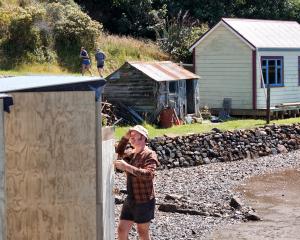Basil Hooper was a leading figure in the New Zealand Arts and Crafts movement. Kim Dungey visits one of the first homes he designed in Dunedin.
As many New Zealanders grapple with housing affordability, Dunedin's Chris and Clare O'Reilly are happily living in a home built in 1906 to address a similar issue.
Their Basil Hooper-designed house in Rosebery St was part of New Zealand's first state housing scheme, designed to help workers into good quality, cost-effective housing.
The cottage with bungalow features is one of several Hooper homes to attract attention as homeowners and architectural enthusiasts launch a website to showcase the work of one of New Zealand's most significant Arts and Crafts architects.
The group also hopes to develop a research archive of Hooper's work at the Hocken Library and an online resource documenting his projects as it works towards an exhibition and a publication.
More than a century after their home was built, Clare O'Reilly says the layout of the three-bedroom house remains largely unchanged.
''We're really thrilled that after all this time it still works so well as a family home. It's not the largest or the grandest Basil Hooper home in Dunedin but it's special in its own right.''
The Windle settlement the home is in was developed just as Hooper was establishing his career in Dunedin but the son of missionary parents would go on to play an important role in introducing New Zealanders to the principles of the English Arts and Crafts movement.
His designs were a departure from the richly decorated late Victorian villas which were the norm in Dunedin at the time and, according to Ralph Allen, author of Motif and Beauty: The New Zealand Arts and Crafts Architecture of Basil Hooper, satisfied his own demanding standards for ''proportion, beauty and utility''.
The O'Reillys' Belleknowes home bears all the hallmarks of Hooper's signature style, from its recessive entrance and informal planning to the offset bay window sitting slightly askew in the front gable.
The house also represents a change in housing policy, heritage consultant and curator Michael Findlay says.
At the turn of the 20th century, there was international concern about workers living in overcrowded, insanitary conditions and the social problems it was believed this generated.
The Workers' Dwellings Act of 1905 enabled settlements to be built in four centres and the plans, drawn by architects rather than builders, were presented to audiences in England as being at the cutting edge of international housing policy.
Hooper had worked in the housing section of the London County Council architects' department.
The large blocks of flats he worked on there were very different in scale to the Windle houses but as Ian Lochhead wrote in Art New Zealand in 1986, shared the same attention to detail, use of clear, direct forms and concern for simple, honest construction.
Prime Minister Richard Seddon wanted to have a variety of plans to choose from so the areas would not be branded government houses.
Hooper's design, which was used for three houses in Rosebery St and one in nearby Newport St, featured casement windows and a veranda over the front entrance.
The wash-house and toilet were separate from the main building but with covered access.
''Private architects were involved, rather than the Government supplying designs and managing the whole process in a centralised way,'' Mr Findlay says.
''It was an early effort to provide public housing of a better standard than people expected.''
The houses designed by Hooper and other Dunedin architects were praised for their attractive appearance but the scheme targeted the working man and his family, not the poor, unemployed or elderly who arguably most needed better housing.
Built on a former golf course, the Windle settlement - like other such subdivisions - was also criticised for being too far from city-centre workplaces.
''It was a pilot scheme,'' Mr Findlay says.
''They thought there would end up being 5000 houses around the country but in the end there were only about 600.''
Transport was not an issue when the O'Reillys bought their home seven years ago, however.
Not only was it close to work and the university, the house had a big, ''quarter-acre'' section, says Mr O'Reilly, a locomotive engineer who has the kind of skills targeted by the 1905 scheme.
The many windows let in plenty of light and the stud height is slightly lower than a villa's, making it easy to heat.
Previous owners had replaced the high skirting boards and changes just inside the front door suggest a timber arch might have been removed.
But more welcome renovations occurred in the 1990s when the toilet was moved inside and a north-facing living room with recycled floorboards and bay window was added at the rear.
More recently, weatherboards have been replaced and insulation added.
Hoping to glean information from the newly formed Hooper group, the O'Reillys also plan to find door handles from the era in which the house was built and to reinstate two fireplaces which have been covered over.
Although the bathroom retains its original clawfoot bath, a window has replaced what was an external door, an unusual feature that remains in another of Hooper's houses in St Clair.
Mr Findlay wonders if the door was there for ventilation and health reasons; after having a bath, the owner might have opened it and towelled himself off while an ''invigorating breeze'' blew in.
The owners say there was once a boiler next to the bathroom and the door would have allowed the owner to bring coal in from outside.
Whatever the real purpose, it could remain a mystery.
Hooper did not leave a practice archive and it is rare now to find any of his original drawings.
Hooper group convener Elizabeth Pack says that is one reason members are keen to contact owners and former owners: ''The thought is that if we can find out who the previous owners of the houses were, we may be able to find some treasured drawings and plans.''
The Hooper project
Architect Basil Bramston Hooper (1876-1960) was a leading figure in the New Zealand Arts and Crafts movement.
Born in Lahore, India, he trained with Dunedin architect Louis Salmond and worked in England before establishing his own firm in Dunedin in 1904.
Hooper's projects ranged from rectangular bungalows with simple, low-pitched roofs to two-storeyed, steep-roofed Arts and Crafts houses. He also designed some commercial buildings and was commissioned by English architects Seddon and Wheatley to supervise the building of St Paul's Cathedral in the Octagon.
In 1923, he moved to Auckland, where he designed more than 40 projects, but his reputation was made in the South, where his Arts and Crafts houses are his main legacy.
The Basil Hooper Project Group was formed last year to enhance knowledge of the architect's work. Its next event is at the Dunedin Public Art Gallery on August 8, when Susan Irvine of Heritage New Zealand will give home owners advice on identifying the key Arts and Craft features of their houses.
Few of Hooper's original records remain, so members hope previous owners will contribute to an online archive and may even have drawings or plans.
To provide information, go to hoopersworld.org or email packelizabeth2010@gmail.com or michael.findlay@otago.ac.nz.












